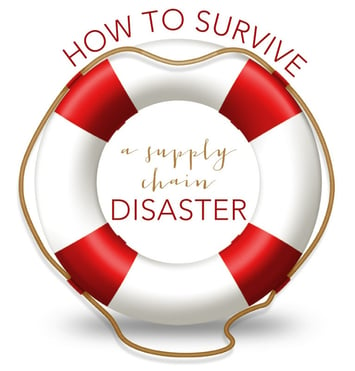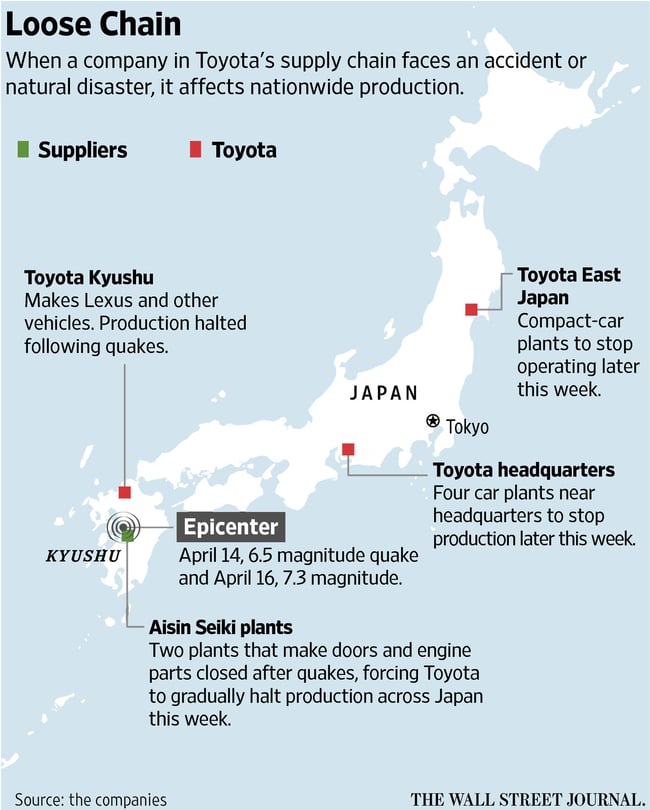 Heard of Murphy’s Law? Don’t worry, it’s not likely that everything will go wrong, but you should be prepared for unanticipated or unplanned crises. It may be every SCM's worst nightmare, but all is not lost if you actually have a plan in place! You'd probably be surprised by how few companies have contingency plans drawn up for dealing with such situations. A crisis is any occurrence that disrupts the usual flow of your supply chain in a major way and/or for an extended period of time. Read on to learn how you can be better prepared for disasters, and pick up some survival tips to help you bounce back in a jiffy.
Heard of Murphy’s Law? Don’t worry, it’s not likely that everything will go wrong, but you should be prepared for unanticipated or unplanned crises. It may be every SCM's worst nightmare, but all is not lost if you actually have a plan in place! You'd probably be surprised by how few companies have contingency plans drawn up for dealing with such situations. A crisis is any occurrence that disrupts the usual flow of your supply chain in a major way and/or for an extended period of time. Read on to learn how you can be better prepared for disasters, and pick up some survival tips to help you bounce back in a jiffy.
Image via Freepik
Disaster, the Three-Headed Beast
According to Jameson Berkow of Canada's Financial Post, there are three main types of disaster: the familiar natural disasters, as well as accidents and labor availability. Let's take a look at these three types and how each can be anticipated and managed should they occur.
1. Natural Disasters
You may be wondering, "How can anyone adequately plan for a natural disaster?" While that is a valid question, it can be done. Instead of trying to gain control over the situation itself, focus on the appropriate way to respond to such a disaster. I think it's safe to presume that one reason many companies don't plan for natural disasters is that they think the chances of a disaster actually happening are relatively low.
Stop concerning yourself with the likelihood of an occurrence. It's undoubtedly better to have a plan in place and never have to act on it than to be forced to take action without any forethought as to what type of response is appropriate! Projecting the possible impact of a disaster on your business will allow you to determine the most fitting reaction to the situation and could ultimately save your supply chain.
A current example of natural disasters wreaking havoc on supply chains are the dual earthquakes that struck southern Japan in April 2016. According to this Wall Street Journal article, "Toyota’s decision to shut 26 car assembly lines this week nationwide due to production halts by a supplier shows how the auto maker’s lean manufacturing system, often viewed as a model of efficiency, can be impacted by disasters. The latest shutdowns drew parallels to the aftermath of Japan’s 2011 earthquake and tsunami."
This is the second incident to substantially affect Toyota's supply chain in 2016. Back in February, an explosion at a steel supplier caused Toyota to halt production for more than a week, resulting in an estimated production loss of between 80,000 and 90,000 vehicles, according to the article.

2. Workplace Accidents
Listen, accidents happen. But they don't have to devastate your entire supply chain in the process. While the bulk of workplace accidents are minor, you should have a plan in place to deal with major incidents as well. Because companies tend to focus on their own operations or their direct suppliers, they oftentimes forgot to consider that something could go awry at a smaller factory feeding the larger chain.
If an accident occurs at a factory supplying goods to your factory or one of your suppliers, there may not be much you can do to control how quickly things get back on track. What you can do is be prepared by qualifying alternate suppliers and having them in your back pocket should something go wrong with a primary supplier.
Put a crisis management strategy in place, and, whatever you do, don’t put all your eggs in one basket. If your supplier encounters an issue and is unable to perform, it's beneficial to have a secondary supplier in place to handle production in the interim.
3. Labor Shortages
The availability of labor is often taken for granted and only comes to mind when a deficit occurs suddenly. These shortages can be a result of a lack of skilled labor, a union strike, a major holiday, or even a disease epidemic.
In the US, a severe shortage of skilled workers is predicted to plague the manufacturing industry throughout the next decade. A 2015 study published by Deloitte and The Manufacturing Institute shows that American manufacturers will encounter a substantial skill gap over the next 10 years. Per the study, “Over the next decade nearly 3.5 million manufacturing jobs will likely be needed and 2 million are expected to go unfilled due to the skill gap.” Contributing factors include baby boomer retirement and a shortage of millennials (who will account for 50% of the US workforce by 2018) showing interest in turning manufacturing into a long-term career.
This phenomenon is something companies should be planning for now, rather than waiting and hoping the situation will improve. If a skill gap does occur, companies may need to begin relying more heavily on automation and collaborative robotics – essentially focusing on improving efficiencies wherever possible – ultimately requiring fewer workers on the line.
Another example of a labor shortage phenomemon is the mass exodus of factory workers during Chinese New Year (CNY), which takes place in January or February each year, depending on the lunar calendar. Basically, business in China comes to a screeching halt during CNY. Factories stop producing, ships stop sailing, and – most importantly – almost all exports from China and the surrounding areas stop altogether. After the holiday ends, many migrant workers take their time traveling back to work, or they don't return to the factories at all. This can result in a slow post-CNY production ramp-up due to labor shortages and the need to train new employees on the line. Coordinating with your Chinese suppliers before CNY to make sure they have a labor replenishment plan in place would be a very wise decision!
Read More: The Ultimate Planning Guide for Chinese New Year
Disasters don't have to derail your business. Anticipating them and their potential impact on your operations will help you make the right decisions and recovery as quickly as possible. Stay tuned for a piece about the leadership skills needed to properly manage a crisis.
Building a Circular Supply Chain for a Circular Economy
4 Steps to Building Your Circular Supply Chain [Infographic]
5 Tips to Diversify Your Supply Chain
5 Tips to Reduce Supply Chain Risk
Setting Up a Green Supply Chain in 2016




.jpg?width=176&height=56&name=MR_associatedNetwork_logo%20(1).jpg)